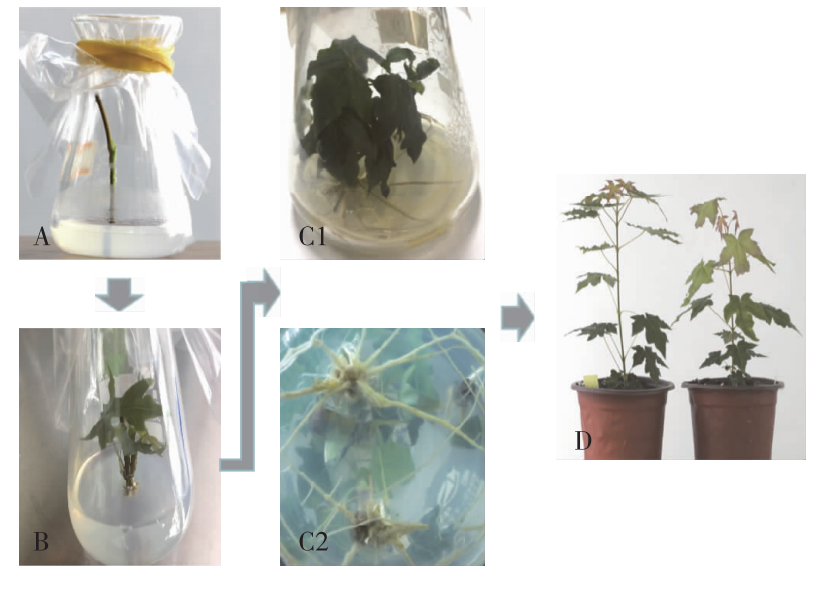 PDF(1565 KB)
PDF(1565 KB)


Study on tissue culture and rapid propagation of Acer truncatum Bunge
MA Qiuyue, LI Qianzhong, LI Shushun, ZHU Lu, YAN Kunyuan, LI Shuxian, ZHANG Bin, WEN Jing
Journal of Nanjing Forestry University (Natural Sciences Edition) ›› 2021, Vol. 45 ›› Issue (2) : 220-224.
 PDF(1565 KB)
PDF(1565 KB)
 PDF(1565 KB)
PDF(1565 KB)
Study on tissue culture and rapid propagation of Acer truncatum Bunge
 ,
,

【Objective】To establish a rapid propagation system, disinfection method and optimal medium were screened, which will lay the foundation for research on the breeding of Acer truncatum seeding. 【Method】The effects of different sterilization treatment mehods, basic media (1/2 MS, MS, 1/2 NN69, NN69), and plant hormones (IBA) on axillary buds and rooting were investigated using stems with axillary buds of A. truncatum. 【Result】When the stem with axillary buds was sterilized with 75% (volume fraction) alcohol for 30 s and 0.1% (mass fraction) HgCl2 for 180 s, the survival rate was the highest. The NN69 medium supplemented with 0.2 mg/L IBA showed the highest axillary bud induction rate (97.2%) with the shortest time (10-15 d). The 1/2 NN69 medium supplemented with 0.4 mg/L IBA was suitable for plantlet rooting, with a rooting rate of 87.8%. 【Conclusion】The optimal sterilization method for stem segments of A. truncatum with axillary buds was 75% alcohol for 30 s and 0.1% HgCl2 for 180 s. The optimal medium for axillary bud induction was NN69 with 0.2 mg/L IBA, and the optimal rooting medium was 1/2 NN69 with 0.4 mg/L IBA. The successful cultivation substrate was prepared by mixing peat, humus,and roseite at a volume ratio of 7:2:1, and the survival rate was 95.0% when the plantlets were moved to the nursery. The results of this study can provide a basis for large-scale propagation of A. truncatum.

Acer truncatum / tissue culture / rooting / rapid propagation
| [1] |
任红剑, 丰震, 乔谦, 等. 元宝枫叶片形态特征的地理变异[J]. 西北林学院学报, 2018,33(1):113-119.
|
| [2] |
|
| [3] |
黄相中, 李聪, 古昆, 等. 元宝枫叶提取物的稳定性及抗氧化活性研究[J]. 云南大学学报(自然科学版), 2003,25(5):442-445,448.
|
| [4] |
王性炎, 樊金栓, 王姝清. 中国含神经酸植物开发利用研究[J]. 中国油脂, 2006,31(3):69-71.
|
| [5] |
|
| [6] |
|
| [7] |
|
| [8] |
于震宇. 元宝枫愈伤组织培养及其黄酮类化合物积累的研究[D]. 杨凌:西北农林科技大学, 2004.
|
| [9] |
李艳菊, 陶加洪, 王兰珍, 等. 元宝枫组织培养研究[J]. 北京林业大学学报, 2005,27(3):104-107.
|
| [10] |
袁云香, 商澎. 小果卫矛组织培养与快速繁殖[J]. 植物生理学报, 2020,56(6):1243-1247.
|
| [11] |
刘占彬, 袁庆华. 多花黑麦草种子外植体组织培养灭菌方法研究[J]. 草地学报, 2009,17(4):474-479.
|
| [12] |
张帆, 叶露, 董姬妃, 等. 高盆樱桃的组培快繁研究[J]. 南京林业大学学报(自然科学版), 2018,42(3):111-116.
|
| [13] |
官锦燕, 谭嘉娜, 罗剑飘, 等. 牛樟的组织培养和植株再生[J]. 南京林业大学学报(自然科学版), 2016,40(4):63-68.
|
| [14] |
张静, 牛喆, 范卫芳, 等. 狭叶黄芩组织培养再生体系的建立[J]. 植物研究, 2020,40(1):50-57.
|
| [15] |
苏梦云. 美国枫香茎段组织培养与植株再生[J]. 林业科学研究, 2005,18(1):98-101.
|
| [16] |
史港影, 南程慧, 伊贤贵, 等. 雪落樱再生体系的建立[J]. 南京林业大学学报(自然科学版), 2014(S1):20-24.
|
| [17] |
牟海飞, 刘洁云, 黄永才, 等. 火龙果离体培养茎段灭菌及芽诱导增殖研究[J]. 西南农业学报, 2017,30(6):1439-1444.
|
| [18] |
李艳敏, 孟月娥, 赵秀山, 等. 金叶复叶槭组织培养技术研究[J]. 河南农业科学, 2008,37(7):98-99.
|
| [19] |
李岩岩. 茶条槭组织培养与快速繁殖技术研究[J]. 山东林业科技, 2010,40(2):48-50.
|
| [20] |
顾地周, 丛小力, 姜云天, 等. 色木槭的组织培养与快速繁殖[J]. 植物生理学通讯, 2008,44(2):314.
|
| [21] |
王盼盼. 黑木相思不同优良无性系组培快繁技术比较研究[D]. 福州: 福建农林大学, 2011.
|
| [22] |
李玲莉, 郭素娟, 李吉跃. 北美柔枝松组织培养研究[J]. 北京林业大学学报, 2010,32(3):209-212.
|
| [23] |
陈茜, 范佳露, 王宝腾, 等. 落叶型冬青雌、雄株茎段的组织培养技术[J]. 南京林业大学学报(自然科学版), 2017,41(6):181-186.
|
| [24] |
宋跃朋, 陈盼飞, 卜琛皞, 等. 高产优质毛白杨良种组培繁育体系构建[J]. 北京林业大学学报, 2019,41(7):121-127.
|
/
| 〈 |
|
〉 |